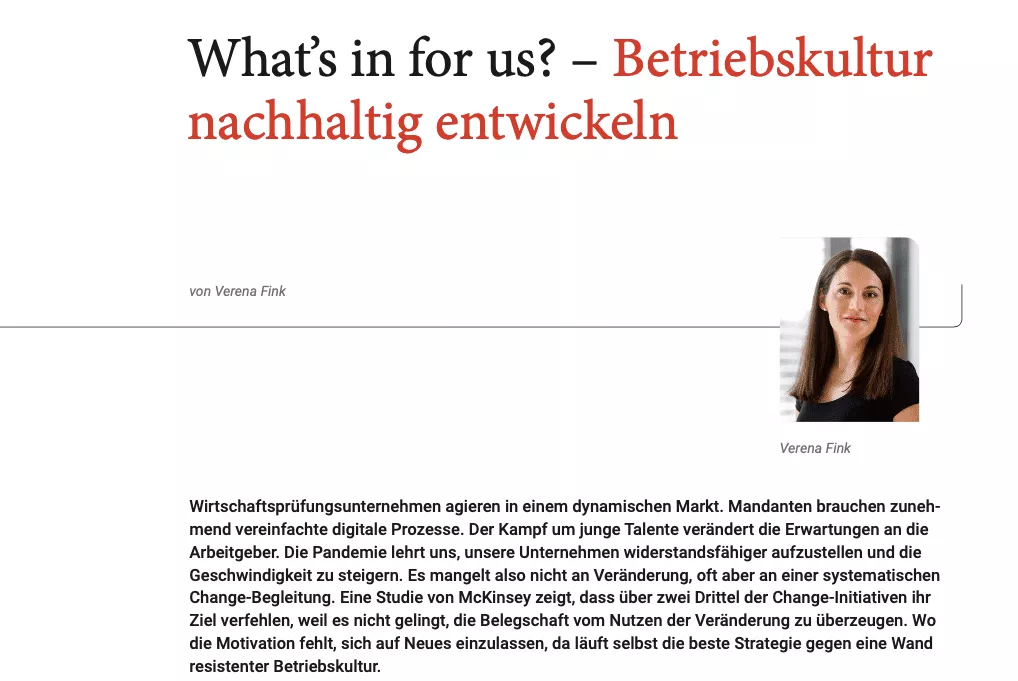Accounting firms operate in a dynamic market. Clients increasingly need simplified digital processes. The battle for young talent is changing expectations of employers. The pandemic is teaching us to make our companies more resilient and to increase speed. So there is no shortage of change, but often a lack of systematic change support. A McKinsey study shows that more than two-thirds of change initiatives miss their target because they fail to convince the workforce of the benefits of change. Where there is a lack of motivation to embrace something new, even the best strategy runs up against a wall of resistant corporate culture.
6 tips for successful culture change:
1. Change needs meaning
If you want to successfully develop your corporate culture, you need lasting commitment from your managers. Management alone will not be able to carry it through the organization. To ignite enthusiasm for the target image, it helps to make the WHY tangible. Leaders at all levels must see the advantage and benefit of the desired target state, so that in the next step they can communicate it credibly and authentically from their own conviction. “What’s in for us?” is a question that, in my experience, is too rarely asked. Once each leader has found an answer to this for themselves and their team, they can lead by example by demonstrating the desired behavioral changes in their own interactions in the workplace.
2. From the abstract to the concrete
A corporate culture is often described with lofty phrases on the level of abstract values. There is nothing wrong with this, as long as someone takes care of the translation so that the cultural formulations become tangible in all aspects of daily work. Companies can develop a common language for their cultural ideals and make it concrete in the description of new desired behaviors. How would you recognize that you have come a little closer to this culture? The best way is through observable behavior.
3. continuous communication
Change initiatives often start with a big bang and then employees hear nothing for months. As soon as the big news is published, things quickly become uneasy if nothing concrete follows. Employees wonder, “What does this mean for me?”, “Is my job in jeopardy after all?”, “Will anything change in my team?”. Companies striving for a culture change should remain transparent and be in regular exchange with the workforce. In addition to the “why,” any change initiative will benefit from a clear roadmap with information sessions where leadership also roughly outlines the next steps and provides updates on progress. What can help additionally is a forum on the intranet with moderated discussion or live question sessions as points of contact and transparency. It also makes sense to identify key players and know-how providers and to involve them early on in the process.
4. pulse check
People want to be involved and listened to, and this is especially true in times of change. The development of a company’s own culture is about a living organism, and this organism can speak. If you regularly gather feedback from your employees, you will get direct feedback on how the initiatives you have launched are working, where information is seeping away, or whether the messages received are quite different from those intended by the management. Today, digital feedback tools make it quick and easy to take the pulse of the workforce. Instead of epic questionnaires, the team can be surveyed online on a monthly or quarterly basis. A comparison of the results reveals trends, progress, setbacks or deficits, which provide starting points for corrective action. Each feedback loop should be planned in such a way that the results are not only evaluated and filed, but also picked up, translated into measures and fed back to the team. Otherwise, the participation rate in the pulse check will drop drastically.
5. celebrate progress
A possible reaction to the pulse check can be the recognition and appreciation of experienced progress. The more examples are collected where elements of the new culture are already observable, the better. Concrete examples make it tangible for the entire team where the path is leading. All those who have already set out on the path and show these behaviors are seen and appreciated for their commitment. Recognizing successes and achievements that exemplify the desired culture goes a long way toward encouraging more employees to embrace the initiative and motivating the trailblazers to keep going. Recent studies show that over 90 percent of employees who are valued for a particular action are more likely to repeat that action in the future.
6. managing culture professionally
As already mentioned, “staying the course” is required when it comes to sustainable change in a company culture. This applies first and foremost to managers. To ensure that culture is not de-prioritized as a soft factor, change should be actively managed like a complex long-term project. Instead of delegating culture to one person in Human Resources, a powerful project team with representatives from various departments is needed. The best case scenario is that the project team consists of people who are passionate about the new culture. Apart from passion, they need the necessary backing and time. As is customary today in cross-functional and agile teams, the culture team should also take time for the retrospective and for the evaluation of the pulse checks in order to learn from mistakes and to act close enough to the workforce. This is the only way to transform culture change into a sustainable and substantial transformation.
In my experience, the success of this effort becomes apparent quite soon: The teams go beyond the silo boundaries and work together on solutions to challenges. The organization reacts more flexibly and quickly to changing requirements or bottlenecks. Employees no longer use “we” to mean their own team, but the entire organization. Customer feedback shows that employees provide advice and support on the basis of their own conviction. This enthusiasm is infectious!
